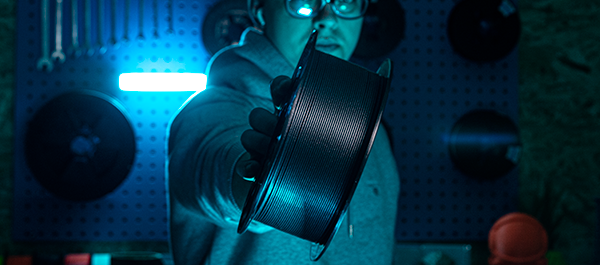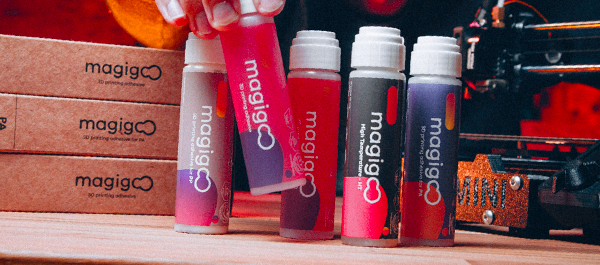Are you an experienced printer, or are you just starting out? An overview of all types of filaments and their possible pitfalls is helpful for everyone. So that you don't go astray when choosing printing material, we have prepared a brief summary of the most important things you should know before buying.
Are you an experienced printer, or are you just starting out? An overview of all types of filaments and their possible pitfalls is helpful for everyone. So that you don't go astray when choosing printing material, we have prepared a brief summary of the most important things you should know before buying.
1. What is filament
The filament is the English word for thread. 3D printing is about the printing material that your 3D printer works with. You buy the selected filament as a string wound on a spool. There is a wide range of materials on the market, from pure plastic to plastic filaments with additives. In recent years, however, such filaments have also appeared, which have a basis in a completely different material than plastic.

2. What to know about filament
Of course, each type of filament has different properties and parameters. It is you who decide on your choice. You should also consider your printer's capabilities so that it can work with the given filament. At the same time, think about what you want to print. So what do you need to be aware of when choosing a new filament?
The primary data you should be most interested in is the diameter of the filament. In the offer, you will find strings with a diameter of 1.75 mm and 2.85 mm. Before you buy filament, check which of the diameters your printer needs. The maximum temperature of the nozzle of the 3D printer is no less important. Here you have to consider the printing material's properties and speed. The tool is simple – slow print = lower nozzle temperature, fast print = higher nozzle temperature. The choice of filament also adapts to this. You should also be interested in the necessary temperature of the mat to keep the printed object on the mat. The material's elasticity is also closely related to this, so the object does not crack during printing. Cracking itself is caused by shrinkage during printing; for example, ABS, ABS-T, PAJet, PC/ABS, and PEIJet do not maintain a constant temperature around the object. The print cools, curls, and tears in layers. Do not forget about temperature resistance, i.e., the maximum temperature the material can withstand after printing.
You can find all this information in a clear manner with each filament we offer. After finding out all the necessary properties required by the printer and, at the same time, the 3D object you want to print, choosing the printing material is a piece of cake for us.
3. What to watch out for
Not all filaments can "smell" to us, like basic PLA, PETG, and others. ABS, ABS-T, PC/ABS, PaJet, or Resins can cause some filaments to smell unpleasant during printing. When working with these filaments, it is therefore important to work only in a well-ventilated room and, if possible, to limit the time you are in front of an active 3D printer as much as possible. You should definitely not eat food near the 3D printer, as it could contaminate it.
4. Types of filament
You already know what filament is and how to proceed with its selection. You even already know all the possible traps. But which filament is really suitable for your planned model? After finding all the properties and parameters you need for your print, you must find the material that meets these values. So which one will it be?

PLA
Starting material with good mechanical properties. If you are starting with 3D printing, it should be noticed. It is suitable for printing large and small objects. PLA is made from corn starch and is biodegradable. Not ideal for outdoor use due to low-temperature resistance and resistance to UV radiation.
PLA+
Improved PLA. Due to its lower printing temperature of 195 °C, the filament is suitable for bridging and printing overhangs. PLA+ is more flexible under stress, offers a higher viscosity during printing (does not clog the nozzle), and better tolerates insufficient printer cooling in a warm environment. It is suitable for 3D pens and has an attractive matte finish.
You can choose from several exciting editions; of course, our recycled filament RePLA+ is also available.
PETG
Everyone is undoubtedly familiar with the material PET, from which, for example, bottles are made. In addition, G stands for glycol, which modifies the properties of PET. This makes the material less brittle and easier to print. It is a versatile, solid, tough filament with good thermal stability, which is excellent for beginners. PETG is suitable for 3D printing large objects without small details. It offers better mechanical properties than ABS, with similar printing properties to PLA.
Also try our RePETG recycled filament.
ABS
One of the first filaments for 3D printers ever. It is the choice of more experienced printers who like to work with demanding details on large objects. ABS is strong and resistant to high temperatures. Easily dissolves in acetone. However, ABS is one of the filaments with a typical odor during printing.
ASA
Successor to ABS. ASA is a thermoplastic combining mechanical strength, UV resistance, and water resistance. Due to its high dimensional stability, it is suitable for prototyping, outdoor use, and the automotive and engineering industries. The filament can be quickly processed with sandpaper, smoothed with acetone vapors, or glued with acetone.
ABS-T
ABS filament enriched with MMA. It is more suitable for more experienced printers. ABS-T is very strong and resistant to high temperatures. It is perfectly soluble in acetone. It is recommended to print with the material in a closed chamber. You can use it for printing smaller objects; its colors are shiny.
INDUSTRIAL
The INDUSTRIAL category includes materials that are more difficult to print and have specific properties. They are suitable for printing mechanical parts and other components.

PA-CFJet - Engineering thermoplastic PA12 with an admixture of 17% carbon fibers. A relatively tough material becomes a harder and stiffer material thanks to carbon fibers. It is used in prototyping, printing printer parts, structural, and mechanically and thermally stressed parts.
CFJet CARBON – Filament based on PETG. It contains 20% carbon fibers, which is why it is characterized by higher strength and stiffness than classic PETG and lowers the volumetric weight. It is suitable for mechanical components and has a beautiful matte finish.
FLEX – A soft and flexible filament resembling rubber. It has higher flexibility, is resistant to abrasion, and dampens vibrations. FLEX is available in two different variants that indicate the degree of elasticity: the harder TPE 32 and the softer TPE 88.
NYLON – Engineering thermoplastic with similar printing properties to ABS. NYLON is highly resistant to high temperatures, pressure, external influences, chemicals, and mechanical wear. It is suitable for rolling and sliding parts, for example, bearings.
PC/ABS – A unique blend of polycarbonate and ABS. It is an extremely strong material that can withstand high temperatures and impacts. You can use the non-flammable filament for mechanical and stressed components. Better to print in a closed press chamber.
ULTEM – Filament suitable for advanced printers and rather industrial printers. ULTEM is extremely strong, highly temperature-resistant, and stable and contains self-extinguishing elements. Usable in various industries from electronics and energy industry, automotive to medicine.
PPJet – Thermoplastic, which we most often encounter in everyday life in the form of packaging, cups, or lids. PPJet is characterized by high toughness and can withstand higher temperatures than PETG or PLA material. The filament is very light and able to float on water.
FRJet – Filament based on PETG. It contains a mixture of special additives with a flame retardant. Therefore it meets the safety standard UL94 V0. FRJet is ideal for electronic components and printing objects without fine details.
5. Try filament
Not only beginners but also advanced printers will appreciate the opportunity to try a material or filament color with which they have no experience yet. With us, you can choose from a wide range of hobby and industrial filament samples, try them out, and then buy the whole spool.

6. Accessories
When choosing a filament, don't forget about suitable accessories that will help you with the realization of a printed 3D object. In addition to adhesives to improve the adhesion of prints to the mats, you can also throw in the basket a 3D mat cleaner, which is great for degreasing.

7. Print sustainably
The sustainable production of our filaments is a priority for us. It does not represent an excessive burden on the environment. Our activity is based on three solid pillars - Simpler, Better, and More Sustainable. These pillars help us make the world of 3D printing better.
If you are not indifferent to this topic, we will be glad if you join us.
More about our responsible mission


